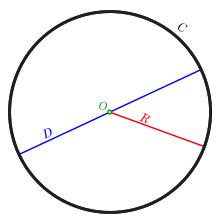Diameter

plane |
|---|
| Geometers |
In geometry, a diameter of a circle is any straight line segment that passes through the centre of the circle and whose endpoints lie on the circle. It can also be defined as the longest chord of the circle. Both definitions are also valid for the diameter of a sphere.
In more modern usage, the length of a diameter is also called the diameter. In this sense one speaks of the diameter rather than a diameter (which refers to the line segment itself), because all diameters of a circle or sphere have the same length, this being twice the radius
For a
For an
The word "diameter" is derived from
Generalizations
The definitions given above are only valid for circles, spheres and convex shapes. However, they are special cases of a more general definition that is valid for any kind of -dimensional (convex or non-convex) object, such as a
If the metric is viewed here as having codomain (the set of all real numbers), this implies that the diameter of the empty set (the case ) equals (
For any solid object or set of scattered points in -dimensional Euclidean space, the diameter of the object or set is the same as the diameter of its convex hull. In medical parlance concerning a lesion or in geology concerning a rock, the diameter of an object is the least upper bound of the set of all distances between pairs of points in the object.
In differential geometry, the diameter is an important global Riemannian invariant.
In
Symbol

The
In
Encodings
The symbol has a
The character will sometimes not display correctly, however, since many
In Microsoft Word, the diameter symbol can be acquired by typing 2300 and then pressing Alt+X.[citation needed]
In LaTeX, the diameter symbol can be obtained with the command \diameter from the "wasysym" package.[6]
Diameter vs. radius
The diameter of a circle is exactly twice its radius. However, this is true only for a circle, and only in the Euclidean metric. Jung's theorem provides more general inequalities relating the diameter to the radius.
See also
- Angular diameter – How large a sphere or circle appears
- Caliper, micrometer, tools for measuring diameters
- Conjugate diameters – Perpendicular diameters of a circle or hyperbolic-orthogonal diameters of a hyperbola
- Diameter (group theory) – measure of a finite group's complexity, a concept in group theory
- Eratosthenes, who calculated the diameter of the Earth around 240 BC.
- Graph or network diameter – Length of shortest path between two nodes of a graph
- Hydraulic diameter – Measure of a channel flow efficiency
- Inside diameter* Semidiameter – Term in geometry; half of a shape's diameter
- Sauter mean diameter – average of particle size
- Tangent lines to circles – Line which touches a circle at exactly one point
- The diameters of a screwthread
References
- CiteSeerX 10.1.1.155.5671. (pdf pages in reversed order)
- ^ Bogomolny, Alexander. "Conjugate Diameters in Ellipse". www.cut-the-knot.org.
- ^ "diameter - Origin and meaning of diameter by Online Etymology Dictionary". www.etymonline.com.
- ^ "Re: diameter of an empty set". at.yorku.ca.
- ^ Monniaux, David. "UTF-8 (Unicode) compose sequence". Retrieved 2018-07-13.
- ^ "wasysym – LaTeX support for the wasy fonts". Comprehensive TeX Archive Network. Retrieved 2022-03-11.














